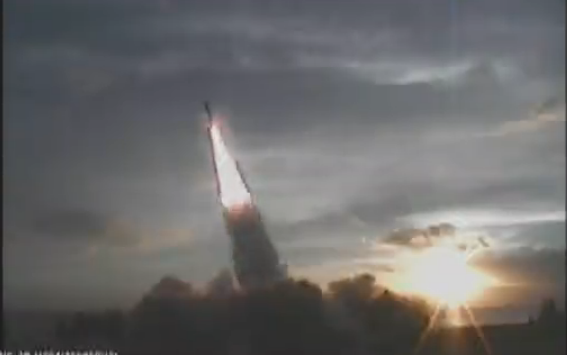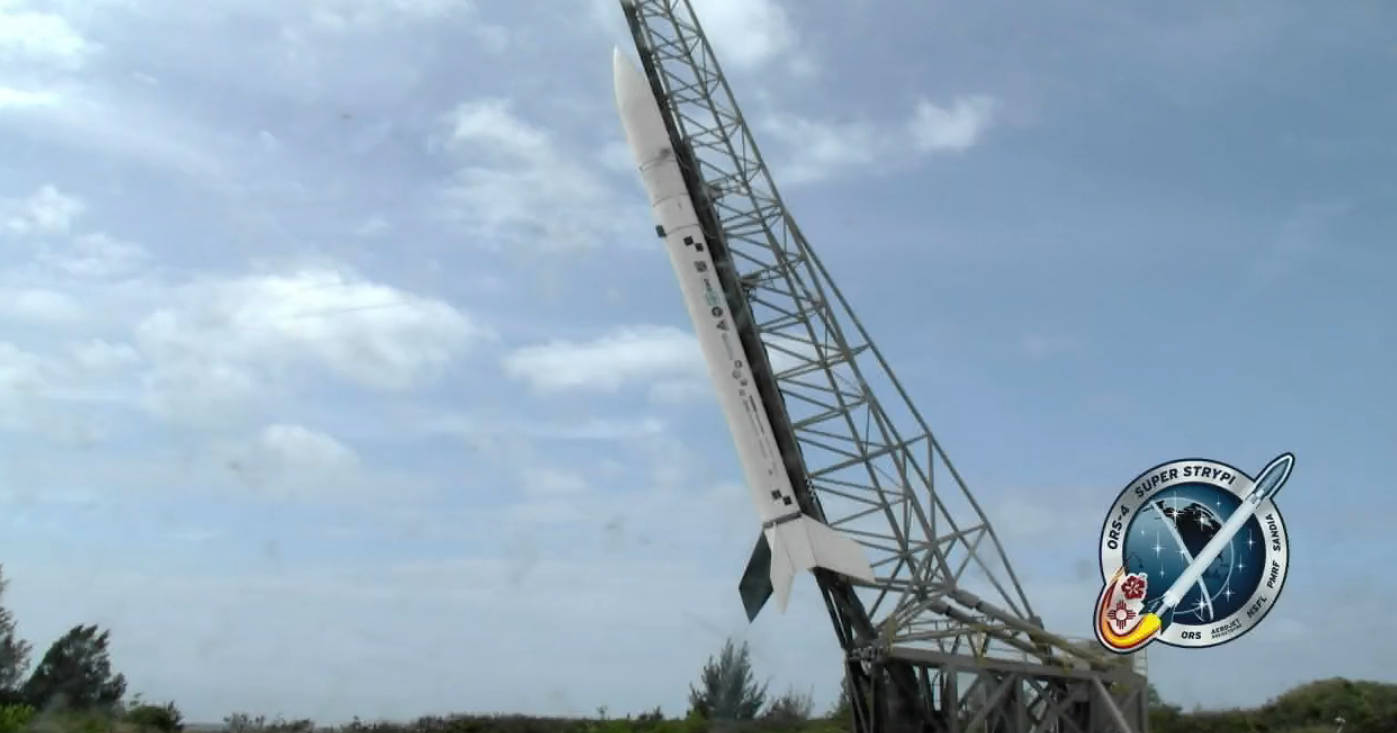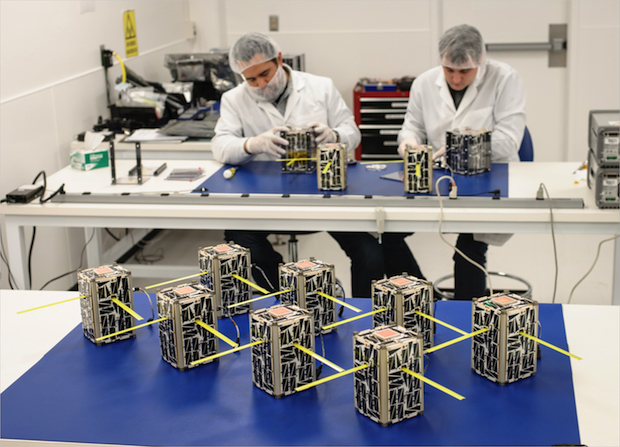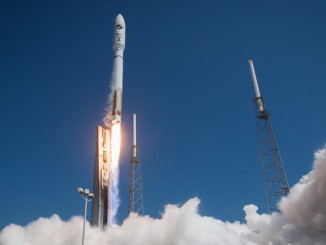
The first flight of an experimental U.S. military rocket designed for low-cost, quick-reaction satellite launches ended in failure over Hawaii on Tuesday, the Air Force said, destroying 13 small spacecraft clustered on the mission for NASA researchers and university students.
It was not apparent what went wrong on the launch, but videos of the flight showed the 67-foot-tall Super Strypi rocket veering out of control and breaking apart about a minute after liftoff from the Navy’s Pacific Missile Range Facility in Kauai, Hawaii.
Billed as a demonstration flight under the management of the Air Force’s Operationally Responsive Space office, Tuesday’s launch took off just before sunset, and the rocket flew steady immediately after firing off a tilted rail launch tower next to Kauai’s western Pacific shoreline.
The rocket surpassed the speed of sound in less than 20 seconds, its solid-fueled LEO-46 rocket motor ramping up to 284,000 pounds of thrust to propel the fin-guided rocket south from the Kauai launch site.
Canted fins at the bottom of the rocket stabilized the booster in a tight spin, a planned maneuver that negates the need for complicated guidance algorithms, one of the Super Strypi’s ways of reducing the costs and complexities of launches.

Engineers targeted the rocket for a polar orbit reaching up to 304 miles, or 490 kilometers, above Earth, where its third stage was programmed to release 13 satellites.
But the rocket’s attitude appeared to oscillate less than a minute after liftoff in video captured from an on-board camera, then the video stream switched to an animation derived from telemetry, which showed the rocket in a tumble. A video recording from a spectator on the ground showed the rocket apparently breaking apart into a debris cloud around the same time.
Live video of the launch provided to Spaceflight Now by the University of Hawaii, a contractor on the Super Strypi program and builder of the mission’s largest payload, ended without explanation moments later.
A spokesperson with the Air Force’s Space and Missile Systems Center in Los Angeles, which oversees the service’s launch efforts, confirmed the mission’s failure.
“The ORS-4 mission on an experimental Super Strypi launch vehicle failed in mid-flight shortly after liftoff at 5:45 p.m. Hawaii Standard Time (7:45 p.m. PST; 10:45 p.m. EST) today from the Pacific Missile Range Facility off Barking Sands, Kauai, Hawaii,” the Air Force said in a statement. “Additional information will be released as it becomes available.”
Military officials were expected to form an investigation into Tuesday’s mishap.
The failure may leave the Super Strypi rocket program in a lurch as the Defense Department weighs how to achieve a long-sought goal of developing a relatively inexpensive, easy-to-operate satellite launcher to haul small spacecraft into orbit in less time and at lower cost than today’s booster options.
Such a capability is important to the military to replace defense-related satellites lost to failure or attack, and commercial operators desire cheaper rides in the growing small satellite business.
Government and industry officials hope the Super Strypi — also known as the Low Earth Orbiting Nanosatellite Integrated Defense Autonomous System, or LEONIDAS — has applications in the commercial industry as a dedicated light-class satellite launcher.
The Super Strypi has no operational missions on the books, but it is sized to pursue a slice of the launch market analysts say is ripe for development. The military is working on up to five small-class rocket programs, including the Super Strypi, and commercial companies like Virgin Galactic, Firefly Space Systems and Rocket Lab have privately-financed mini-satellite launchers in their plans.
The Air Force’s ORS office, established by the Pentagon in 2007, spent more than $45 million on the ORS-4 mission before Tuesday’s demo flight. A NASA technology research project involving eight tissue box-sized CubeSats called the Edison Demonstration of Smallsat Networks was valued at $13.6 million, according to the space agency.
Figures for the investments made by the mission’s other participants, such as universities that built spacecraft carried on the rocket, were not immediately available.
The payloads lost on the Super Strypi were:
- HiakaSat, a 121-pound (55-kilogram) satellite from the University of Hawaii with a hyperspectral imaging camera to test new Earth observation technologies for military and scientific applications
- Edison Demonstration of Smallsat Networks, a mission from NASA’s Ames Research Center consisting of eight 1.5U CubeSats about the size of tissue boxes, designed to demonstrate a satellite swarm concept with radio cross-links and reconfigurable software
- PrintSat, a NASA-sponsored 1U CubeSat from Montana State University with primary and secondary structural components made with additive manufacturing
- Argus, another NASA-sponsored 2U CubeSat from St. Louis University, to study how well modern electronics operate in space by comparing their radiation event rates to ground predictions
- STACEM, a 3U CubeSat the size of a shoebox sponsored by the National Reconnaissance Office and developed by Utah State University’s Space Dynamics Laboratory to test a new optical sensor in orbit for Earth observation
- Supernova-Beta, the first orbital test flight of Pumpkin Inc.’s commercial 6U CubeSat bus, about the size of a small handheld toolbox

Air Force officials admitted they accepted “elevated risk” on the ORS-4 mission over concerns that hot gas inside the LEO-46 first stage motor could burn through insulation lining the composite casing.
Managers said the issue could be easily fixed before casting future Super Strypi rocket motors, but said it was not possible to correct the problem inside motors already built.
Aerojet Rocketdyne produced the solid-fueled motors for the three-stage Super Strypi, building on the company’s solid booster work for the workhorse Atlas 5 rocket.
The Super Strypi launch marked the first-ever satellite launch attempt from Hawaii.
The Air Force funded the University of Hawaii as prime contractor for the Super Strypi’s development, and the institution managed propulsion, design and ground systems contracts with Aerojet Rocketdyne, Sandia National Laboratories and other subcontractors.
The Super Strypi builds on a Cold War-era Sandia sounding rocket used for nuclear weapons tests and research flights.
Repurposing sounding rocket technology for satellite launches is a way to drive down launch costs, officials said.
The Air Force estimates the Super Strypi launch system will cost about $15 million per flight once in production, with a goal of cutting the unit cost to $12 million.
Email the author.
Follow Stephen Clark on Twitter: @StephenClark1.



